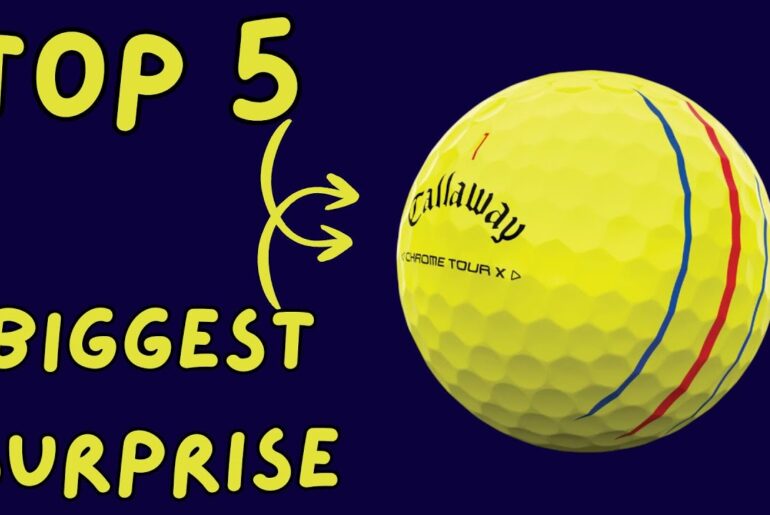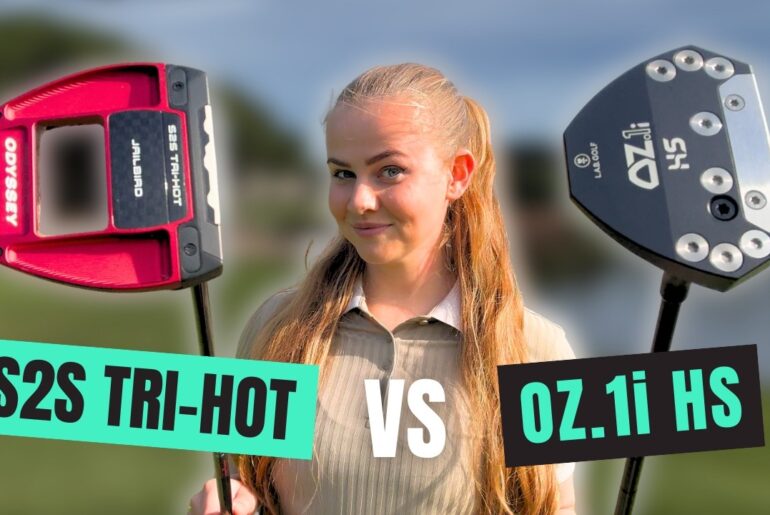In this deep dive, we break down the real technology behind the Callaway X Forged and X Forged Max irons using robot testing, 3D scans, and pro-level fitting insights. Whether you swing it at 80 or 90mph, we’ve got the data that matters.
Check out Jack’s Testing of the X Forged & X Forged Max ➡︎ https://youtu.be/o2Wblnr-SuI
CHAPTERS:
0:00 Intro
1:19 This is a real forging
2:20 Callaway X Forged and X Forged Max Technology
3:23 Callaway X Forged Max 90mph Robot Test
4:10 Callaway X Forged 90mph Test
5:13 Key numbers from the 80mph robot testing data and 3D Scan Data
8:45 Callaway X Forged vs. X Forged Max 80mph Robot Test Dispersion Graphs
9:50 How to effectively adjust lofts to get the best bounce and stopping power
Want to see how these irons perform before you buy?
Drop your questions in the comments – we read and reply!
Like, if you love gear breakdowns
Subscribe for more robot testing, fittings, and gear insights every week.
BOOK A FITTING: https://coolclubs.com/book-fitting/
SIGN UP FOR EXCLUSIVE CONTENT: https://coolclubs.com/newsletter/
🌐 Website
📷 Cool Clubs Instagram
https://www.instagram.com/coolclubsgolf/
👀 Cool Clubs Facebook
https://www.facebook.com/CoolClubs/
What is Cool Clubs?
Cool Clubs is the largest independent club-fitting and custom-building organization in the world. We have club-fitting locations around the planet and are part of the Worldwide Golf family.
Cool Clubs is not affiliated with any club manufacturer; this means we only fit our clients with equipment that performs the best for them.
Research. Fit. Build. Performance.
Trust Your Fit. Trust Your Build. Love Your Game.
Welcome back to the channel. If you like what we’re doing, please hit that like and subscribe button. It helps us grow and give you even more content. We’ve had a really good reaction to all of the videos that we’ve produced. We got all the Callaways out, the titless, the ping. It was a huge week. We’re living stuff in the middle of summer, right? You don’t get a lot of launches like this. So, that’s great. It was basically a launch season for us. We missed the embargo date on this. Basically, we didn’t get one of the heads in time. Yep. Oh, well, but it actually gave us a chance to do something with the robot, right? Yeah. We actually changed the swing a little bit and kind of fine- tuned it a bit more. So that’s helpful. Um, so that’s worth worth waiting. We’re pretty much there now. This robot is now going to launch and spin at what it should at an 80 mph test. Every other test that you see on there is fine. It’s still relative to other clubs in the video. This should just be our test now going forward for everything. So you’ll be able to do some apples to apples at home, which we know that you like doing. Um, today is all about Callaway’s XForge. It’s a call back to I think 201819 was the last time they did this, right? Been a while. fully forged 1020 carbon steel really good-looking golf clubs and they’ve had a lot of success on the LPJ tour. So, they’ve been out there for a while and they’re actually been in in Asia for a bit. Some of them anyway, not the Max is new. Yep. Um but they’ve done really well on the LPJ tour especially. So, and everyone nowadays when you see forged, you actually don’t see a lot of this. No, this is actually a forged club, right? One piece. There’s no hollow body stuff or welded faces or any crazy trickery here. Um, it’s actually just a forged cavity back club and and you know that the standard one’s pretty traditional looking, you know, it’s kind of standard looking for cavity back that a lot of tors have been played for years. The Max is kind of interesting to me. You know, deeper pockets. Um, doesn’t look that different other than the top line from the from the top, but uh certainly a little more forgiving and a little longer. Okay, today’s video we’re going to do a 90 mph test live on camera. Center hit four degrees down, same shaft with both, so you’re going to see apples to apples there. Then we’re going to jump back and we’ve tested these clubs at 80 mph with a bunch of shots. Chris behind us does all the hard work there and puts the yards in. Dr. Mace verifies it. We check the numbers and we get the data to present you with. We’ve got dispersion graphs, average flight, land angles. So hang in there for all of that. First things first, let’s talk a little bit of tech about these irons if there is any, right? But it’s really more about design than just like shape than materials. Let’s put it that way, right? cuz we’ve just got a carbon head that’s, you know, satin finish. Nice finish, by the way. So, in the robot, we got the Max kick us off. We’re going to do the 90 mph test. And look at the I mean, the first thing I see is this sole design. It’s like a tricole. I I like this a lot, actually. I mean, the back’s obviously channeled off a little bit to make the playable width, smaller. Um, but you know, they got quite a big leading edge relief here. Uh, still got a pretty sharp leading edge. Um, but it’s definitely cavity back. And both of these look similar. I didn’t have measured exactly, but they both look, you know, this part here is uh similar. Yeah. Yeah. And then we’ve got noticeable pockets. Hopefully Austin here can get some good B-roll. Big chunks like taken out of the back there to to make a real cavity, right? But they still got a pretty good substantial chunk in the middle. So, it’s really solid feeling, which, you know, for the tour players and better players playing a, you know, larger forge cavity back. Um, gives them still a solid feel in the middle. So, pretty cool. We’ve also 3D scanned these heads. If you watched our titless video, you get to see understand what those numbers are about. Hang in there. We’re going to talk about these compared to one another. And I’ve actually done a little research compared to their new AI 150 I can share with you. So, hold up for that. Let’s hit the 90 mph forged max, right? 31° 7 iron. Yeah. This is probably go further than most players going to want. So, yeah. Okay. 90 mph. Pretty straight. Yeah. Almost dead straight actually. Not a lot of draw fair bias obviously which is what you’d want in a better player club. And although this one has got a little more offset than the other and we kind of negate that with the robot 5800 RPMs we have dialed the swing in so the shaft lean produces more similar to real spin. Um 103 ft in the air landing at 47° that’s really good considering this is 31. That’s kind of strong. Yeah that’s a fairly strong life. That’s that’s a lot better than 80 miles right now. So that definitely helps. Okay, so lock Mark leads in. There’s 80 mph data to come, but let’s snap in the X Forged and see what it does headto-head with Max. Take a look, nice and straight. 121 ball speed. So, we got um two degrees extra loft. This is 33, right? And we lost three miles an hour ball speed. So, we’re thinking about sixish yards. Um and we got 109. Sorry, Mark. I really can’t see 10 105 feet. So, a couple of feet higher for a little bit more. And one degree more descent angle, 6,000 RPM. So, everything’s just that little bit more for that loft. Yeah. But you tell you what, these little cavity pockets they’ve got in here and lower center gravity. Obviously, we’re not seeing the two degree total difference we are seeing for actually the measured loft. Yeah. So, they’ve done some stuff obviously with this weighting and and how it’s distributed to help it. And and I think that’s the point we’re trying to get across a lot. Like when you see delofted, there’s a reason. It’s like just to get it back to do the right thing with the technology. Otherwise, if we put 33 degrees on that, it would be way higher. Straight up in the air. Y right. Um, okay. Next thing is let’s jump into the 80 m hour test. You wanted to take the numbers. So, you go with the key key numbers first. All right. So, you know, offset there’s a little bit of difference there. You know, you got basically uh 0.05 and one uh 0.1. So, um you know, quite a bit of difference there. About half as much offset, but neither one are a lot. Right. So, and they’re progressing through the set. Um, you got your top line thickness. It definitely does look thinner. Um, it’s 0.17 versus 0.20. You know, it’s noticeable. I mean, I can really see that when I stood up. It’s not bad. I looked down there and I’m like top line is the only thing that stood out to me. Yeah. Exactly. Why too? Because the the footprint obviously, you know, the sole is obviously quite a bit bigger. You got 987 versus 931, but not a huge difference. Uh, and obviously, you know, this channel off the back as they round it off, that kind of diminishes the size of it. So, it’s not as big as it looks physically. Um, and obviously the uh the blade length is really not much. Only a millimeter difference. So, that’s why when you look down at it, they look almost identical. Blend totally blendable. You totally can blend them for sure. Obviously, you got two degrees difference, but you’ve got the lower CG in the bigger one. So, it’s really effectively only one degree difference. So, you know, by bending one and a half to stronger, one has to degree weak, you’re probably going to fill those gaps out. Yeah. um you know so you don’t have to do a lot of manipulating because of the difference in the CG obviously. Yeah. Um so you know definitely different but not entirely different. Um the landing angle obviously at 80 miles an hour that’s where you get hurt right and I would definitely say you know you don’t really want to play the either of these clubs much below 80 miles an hour. You know 75 maybe if you hit the ball high. I hit the ball really high at 80 miles an hour. Um so I’d probably get away with it but you know these are really designed for a little more speed than that. um 75 mph probably feel max and and you know obviously the blade you need you know 85 miles an hour you’re really giving up some stuff but you know they’re really good clubs are very similar looking and I definitely think you can blind them. Yeah. So my little tidbit there for the 3D scan data was the AI 150 which is another Apex that’s come out and filled that line in which you think kind of crosses over with that Max a little bit. Yeah. It is these two are like considerably smaller but the topline thickness of the AI50 is a little thinner. So you kind of get a similar package with the AI, right? You get that like 10x face versus, you know, this being a true forge thing. So you get a little more tech, but really the body size isn’t like wildly different to the Max that you’ve got. No, these are definitely not big. And they call us a Max, right? But it is a, you know, it’s it’s a large forge cavity back, but it’s not huge by any means. And and certainly, like you said, the the top line’s not that much different. The Blade Land’s almost identical. Um, it’s not a big bulky club. I mean, there are some huge forge clubs, especially in Japan. Um they’re big, bulky, lots of offset. Um this is not one of those. This is definitely LPJ players for sure. Uh and smaller one, I’m sure there’d be plenty of guys on tour playing that. Yeah. Well, this is a nice challenge. I don’t think they’ve had anything really in the range that have targeted, you know, if you think like T100 and I guess T150 almost T250 in that that case when you think about the models release. It’s it’s it’s a ping blueprint S and like it’s got a lot of competition and I think they’ve done a really nice job to to get in that space honestly. Callaway was kind of missing that a little bit, right? I mean, the old original Apex was a smaller package and everything. They came out with a 200 and 300 which were big. Um, maybe a little bulky for the really good players. Um, you know, but now they got the 150 which is kind of like that players really good club. And both of these fit that category as well and maybe even the titanium one, especially now in the silver T fusion, just the just the regular T fusion. That 250 is a bit bigger again. Right. Yeah. I’ve had a lot of clubs in here. Yeah. I think I’ve rounded out the line with this. If you look at the dispersion data, I mean, I’m looking at that and I’m like, okay, it’s pretty much the same club. The toe drops off, the the uh the thin drops off. They do a really good job with the heel. We know these Forge products, they actually get the center of gravity a little bit nearer the heel. So, you find that they get really tight out of that. And then if you also look at the distance, we kind of talked about this in the 90 mph test. The two degree change, the 31 degree from the Max to the 33 in the Forge gave a six yard difference in carry from a center shot on the 80 mph test. And that’s about right. Right. If you figure there’s typically four degrees between irons and you’re talking 10 to 12 yards between clubs, six degrees is right half of that. So, um, definitely helped a lot there. But interesting thing is the height was pretty close. I mean 91 versus 93 couple of your couple of feet. I mean, it’s not a lot, right? And the stopping power, like you say, I’m a big fan. We we’ve just done this whole experiment knowing that stopping power is like becoming more paramount. We like that people are going away from just pure distance games. Both of these are uh either the Forged is right in that space already. And the Forge Max, you could get it perfect with a little weaken. Yep. Absolutely. Especially if you’re steep, right? If you’re hitting down on it all, I mean, definitely the relief they’ve got on this leading edge is going to help you. And if you bend them a little weak, that’s going to help even more. So, I mean, definitely an option as well. And we’ve heard that from other companies as well recently. We talked about things that uh a lot of companies are building some clubs a little stronger just so they can weaken them for tour players and and the average PJ tour player is, you know, four or five down or four down anyway. Uh LPJ obviously is a lot less. Um but you know, stronger better players that are steeper, I mean, you can definitely bend these things weak. Yeah. You know, people always want to make them stronger, stronger, stronger. Um so, but there’s an option sometimes that making them weaker makes sense. Makes a lot of sense for stopping power. So, there’s a couple of fitting stories here. The better player is like looking at this as a whole or this blended with the Max, right? Then you’ve got the person who’s like desperate to play something as prettier as these and has been in the Apex line and maybe looking between the AI 150 and this, maybe the TI Fusion if they got some extra cash at hand and they want that tech cuz they go millions of miles, right? Um, and it’s all about just getting into a fitting bay and experiencing them hitting them, right? I mean, the advantage of a forge glove like this without a springy face and stuff is, you know, consistency and distance. You know, there’s no hot spots and stuff. It’s pretty much solid face. Um, they’ve obviously moved the CG down to help that a little bit, but you’re going to get consistent distances. Yeah. Jump in the comments. Let us know which one you like the best, which one you think you’re putting in the bag. If the call back to the original XForge gets you thinking, you might want to upgrade to this beautiful new product. Uh, we love to hear from you. Hit that like and subscribe button. And we’ve basically wrapped up all the new releases. Yep. So, we’re going to jump in some new testing, right? We’re going to try a couple new things and uh finish up and test all the stuff the same as we just tested these. So at some point in time and you know towards the end of the summer obviously we’ll be able to do some comparisons on you know what the standouts in certain categories. So stick with us. We got so much more to come. Yeah. [Music]








2 Comments
The Ruroni Kenshin of golf clubs 😀
X Forged seemed to perform better. Tighter dispersion, similar height, not much yardage difference at different lofts. Not sure there's a great reason to play the Max based on these results.